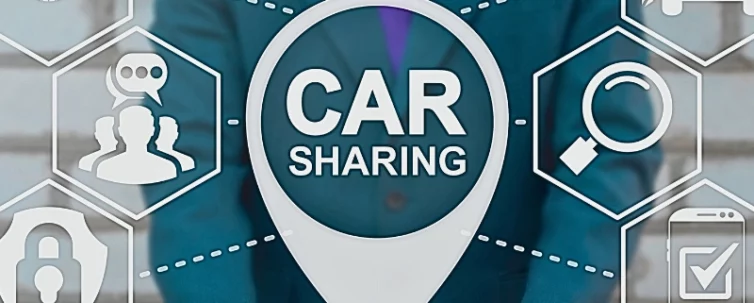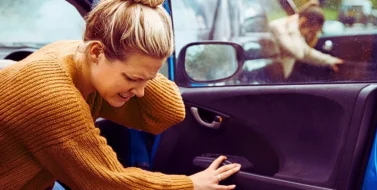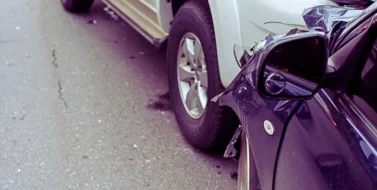Can you file a claim against Uber or Lyft? Depending on the accident and the legal obligations of Uber or Lyft under Illinois law, it might be possible to hold a rideshare company responsible. This could occur if the driver was at fault due to factors like distracted driving or breaking traffic laws, if the incident took place while Uber or Lyft’s insurance was active, or if Uber or Lyft exhibited negligence. Examples of negligence might include inadequate background checks or training.

For assistance with your rideshare accident claim, contact Lloyd Miller Law Group at (773) 838-8100.
Table of Contents
Your Rights After an Uber or Lyft Accident
When filing a claim for an Uber accident, you typically have the right to seek compensation for the following:
- Medical expenses, both past and future.
- Lost income from the past and expected future losses.
- Pain and suffering.
Your medical expenses claim will cover reimbursement for costs related to care from the accident, including both past and future expenses. If your injuries affect your ability to work, you can claim lost income. Additionally, you can claim for pain and suffering, which includes physical and emotional distress. Your Rideshare accident lawyer will assist you in determining the appropriate amount to claim.
Your Rights as an Injured Ride-Sharing Passenger
Injured passengers in Uber or Lyft accidents have the right to seek compensation similar to any other car accident, including claims through their auto insurance or personal injury lawsuits for medical expenses, pain, suffering, and lost wages.
Uber and Lyft are required to maintain significant liability insurance, often exceeding $1,000,000, to operate in places like Chicago, which should help cover injuries. Despite this, insurance companies may attempt to minimize their payouts through quick settlements.
If an accident involves an at-fault driver hitting an Uber or Lyft vehicle, injured passengers can also seek compensation from that driver’s insurance. It’s important for victims to consider future expenses related to their injuries, as catastrophic injuries can result in lifelong costs.
To ensure fair Uber and Lyft accident compensation, consulting a car accident attorney after an accident is vital. Your attorney can evaluate settlement offers and advocate for your rights, ensuring you receive the full compensation you’re entitled to for the damages suffered due to someone else’s negligence.
Your Rights If Hit by an Uber or Lyft
In a situation where you’re hit by an at-fault driver while driving your vehicle, your rights remain the same as in any motor vehicle accident. You can pursue the at-fault driver’s insurance for compensation covering medical expenses, pain and suffering, and lost wages, including future costs. Having an experienced attorney is important to accurately assess the complete costs of your injuries. It’s also important to know how to prove you are not at fault in a car accident when building your case.
Typically, you shouldn’t face issues related to the driver’s insurance coverage, as ride-sharing companies like Uber and Lyft are required to maintain at least $1,000,000 in liability coverage. However, securing a fair settlement can be challenging; insurance companies often try to minimize payouts. It’s advisable not to communicate with them or sign any documents before consulting with a rideshare accident lawyer.
Personal injury claims can be complex, involving legal and insurance aspects that require skill. While you focus on your recovery, your attorney will navigate these aspects and seek all available compensation from Uber, Lyft, the driver, or your own insurance, ensuring you have the support needed for your recovery.
When Can You File a Claim Against Uber or Lyft?
In typical car accident situations, the process usually starts with filing an insurance claim and can advance to the courtroom if needed. However, when an accident involves an Uber or Lyft driver, the procedure differs somewhat. While rideshare companies are considered common carriers, they are not necessarily vicariously liable for a driver’s actions. However, you can still file a claim against the rideshare entity’s insurance company when injured in an accident.
Circumstances Resulting in Liability from Company or Driver Negligence
Common reasons for crashes that may lead to liability for a rideshare company, either due to its negligence or that of its drivers, include:
Driver Fatigue
Many rideshare drivers, often juggling studies or full-time jobs, turn to this work for extra income, which can result in extended driving hours, tight schedules, and insufficient rest.
Distractions
Rideshare drivers frequently face distractions, primarily from the constant need to check their mobile devices for app notifications and navigation. Other distractions can include texting, emailing, eating, or even putting on makeup.
Driving Under the Influence
Impairment from alcohol or drugs affects a driver’s concentration, judgment, and responsiveness in emergency situations. The misuse of prescription medications, such as opioids and psychotherapeutic drugs, also contributes to many accidents.
Traffic Rule Violations
This includes actions such as speeding, aggressive driving, and ignoring stop signs or traffic signals.
Mechanical Failures
Neglecting vehicle maintenance can lead to malfunctions in critical mechanical components, like brakes.
Negligent Driver Screening
Rideshare companies typically perform driving record assessments and criminal background checks on drivers before granting access to their platforms. However, if these checks are inadequately executed or overlooked, it may result in approving a dangerous driver with a history of multiple offenses to transport passengers.
How the Phase of the Ride Influences Insurance Claims
You might be eligible to file an insurance claim with Lyft and Uber. Both companies offer insurance for their drivers, but these policies are only active during certain time periods:
- Period 0: The driver is not using the app and is not searching for passengers. Any damages are covered by the driver’s personal auto insurance.
- Period 1: The driver is logged into the app and actively seeking passengers, but there are no passengers currently in the vehicle.
- Period 2: The driver has accepted a ride request and is en route to pick up a passenger.
- Period 3: The driver has picked up the passenger and is transporting them to their destination. After dropping off the passenger, the driver goes back to Period 1.
During Period 0, if a driver uses their car personally, their personal insurance covers accident damages. If the driver works for Lyft or Uber, you cannot claim against the rideshare company’s insurance unless they are actively using the app for rides.
In Period 1, if the driver has a rideshare endorsement, it serves as the primary insurance, covering damages up to its limits. If not, Lyft and Uber provide third-party liability insurance, which covers injured victims, but not the driver, with caps at $50,000 per person for bodily injury, $100,000 per accident for bodily injury, and $25,000 for property damage.
During Periods 2 and 3, Lyft and Uber offer extended coverage, including $1 million for third-party liability, underinsured/uninsured motorist coverage, and collision coverage after a $2,500 deductible.
If the driver is logged in, passengers and third parties can claim against Lyft or Uber’s insurance. If not, it becomes a personal injury case, which may lead to lower compensation. The driver may lack sufficient insurance, and recovering damages could be difficult, as they would need to pay out of pocket.
Establishing Liability in a Rideshare Accident
To file a claim against a rideshare company, you need to demonstrate that it is liable for the accident. Proving liability in such cases involves several crucial steps:
Determining the Driver’s Status
You must assess whether the driver was off duty, awaiting assignments, or transporting a passenger. This status will affect the type of insurance coverage available.
Collecting Evidence
Gathering convincing evidence is vital. This includes accident reports, eyewitness accounts, medical documentation, and relevant surveillance footage.
Establishing Negligence
You need to show that either the rideshare driver or another party acted negligently. This could mean proving that the driver was distracted, speeding, or behaving recklessly. Additionally, the rideshare company may be held liable.
Ultimately, establishing liability involves determining who is at fault, with the key question to answer is: whose actions or inactions caused the accident? To establish liability, you must demonstrate negligence, which requires showing four key elements:
- The Ridesharing Company/Driver Owed You a Duty of Care
- The Ridesharing Company/Driver Breached Its Duty
- The Ridesharing Company’s/Driver’s Failure Led to Your Injuries
- You Suffered Damages
How a Rideshare Accident Lawyer Can Help You
Understanding how much a rideshare accident is worth is crucial to ensure you receive fair compensation for your losses. Your attorney can provide valuable insights into the various factors that influence settlement amounts, helping you navigate the claims process with confidence and effectiveness. When pursuing compensation after a rideshare accident, your lawyer should know what to do after a rideshare accident to assist you in recovering from your losses. Your attorney may help you by:
Reporting Your Accident
The first step in seeking compensation is to report the incident to both the rideshare company and the police. Once the report is made, Lyft or Uber will initiate an investigation promptly.
Collecting Evidence
Accumulating evidence is vital for constructing a strong claim. This may include taking photographs of the accident scene, gathering witness statements, collecting medical records, and retrieving pertinent documentation related to the incident and your injuries.
Filing an Insurance Claim
After gathering all necessary evidence, your lawyer can file a claim with the rideshare company’s insurance provider. This usually involves submitting a comprehensive account of the accident along with supporting documents.
Negotiating a Settlement
Following the claim submission, you and your lawyer will engage in discussions with the insurance company to reach a settlement agreement. This process helps determine the appropriate compensation for your injuries and losses.
Pursuing Litigation if Needed
Statistics indicate that roughly 5% of car accident claims end up in court, with the majority getting resolved through settlements. However, if negotiations do not lead to a satisfactory settlement, you may choose to pursue litigation by filing a claim against Uber or Lyft and presenting your case in court, where a judge or jury will determine the outcome.Navigating the claims process can be daunting, especially with the involvement of insurance companies and legal intricacies. Attorneys experienced in personal injury law can support you after your accident, helping you to maneuver through this process and protect your rights. Contact us at Lloyd Miller Law Group for legal assistance following a Lyft or Uber accident.





